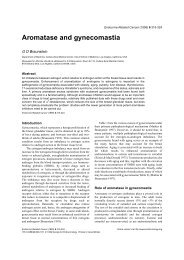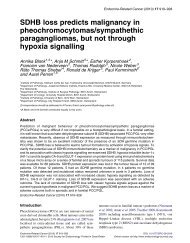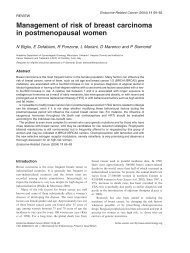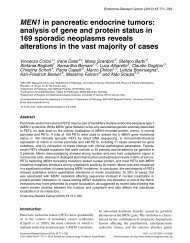Somatostatin-producing neuroendocrine tumors of the duodenum and
Somatostatin-producing neuroendocrine tumors of the duodenum and
Somatostatin-producing neuroendocrine tumors of the duodenum and
You also want an ePaper? Increase the reach of your titles
YUMPU automatically turns print PDFs into web optimized ePapers that Google loves.
N Garbrecht, M Anlauf et al.: <strong>Somatostatin</strong>-<strong>producing</strong> <strong>tumors</strong><br />
Introduction<br />
Neuroendocrine <strong>tumors</strong> (NETs) <strong>of</strong> <strong>the</strong> stomach,<br />
intestine, <strong>and</strong> pancreas are heterogeneous, as far as<br />
<strong>the</strong>ir morphology, function, <strong>and</strong> biology are concerned.<br />
The WHO classification <strong>the</strong>refore distinguishes <strong>the</strong><br />
gastroenteropancreatic NETs according to <strong>the</strong>ir<br />
location, histopathology, proliferative activity, extension,<br />
functional activity, <strong>and</strong> hereditary background<br />
(Klöppel et al. 2004). Recently, a tumor node<br />
metastases (TNM) disease staging system was proposed<br />
(Rindi et al. 2006) in order to facilitate<br />
<strong>the</strong> st<strong>and</strong>ardization <strong>of</strong> <strong>the</strong> diagnosis <strong>and</strong> <strong>the</strong>rapy<br />
<strong>of</strong> NETs.<br />
NETs <strong>producing</strong> mainly somatostatin (SOM-NETs)<br />
have been observed in <strong>the</strong> <strong>duodenum</strong>, pancreas, bile<br />
ducts, <strong>and</strong> ovaries (Larsson et al. 1977, Chamberlain &<br />
Blumgart 1999, Gregersen et al. 2002, Klöppel et al.<br />
2004, Bastian et al. 2005). In <strong>the</strong> <strong>duodenum</strong>,<br />
SOM-NETs have been reported in <strong>the</strong> setting <strong>of</strong> both<br />
<strong>the</strong> multiple endocrine neoplasia type 1 (MEN1;<br />
Anlauf et al. 2007) <strong>and</strong> <strong>the</strong> neur<strong>of</strong>ibromatosis type 1<br />
(NF1) syndromes. <strong>Somatostatin</strong> expression was also<br />
found in gangliocytic paragangliomas (GCPGs; Hamid<br />
et al. 1986, Tischler et al. 2004). All <strong>of</strong> <strong>the</strong>se <strong>tumors</strong><br />
are uncommon. Our knowledge <strong>of</strong> <strong>the</strong>ir incidence,<br />
histopathology, biology, hereditary background, <strong>and</strong><br />
functional activity is <strong>the</strong>refore based on reports <strong>of</strong><br />
single or small series <strong>of</strong> patients <strong>and</strong> reviews<br />
(Hamid et al. 1986, Tomic & Warner 1996, Soga &<br />
Yakuwa 1999).<br />
In this study, we analyzed a series <strong>of</strong> 623 resected<br />
duodenal <strong>and</strong> pancreatic NETs by identifying <strong>the</strong>ir<br />
immunophenotype <strong>and</strong> <strong>the</strong> relevant clinical symptoms<br />
at <strong>the</strong> time <strong>of</strong> diagnosis. In particular, <strong>the</strong> following<br />
questions were addressed: (1) what is <strong>the</strong> relative<br />
frequency <strong>of</strong> duodenal <strong>and</strong> pancreatic SOM-NETs <strong>and</strong><br />
GCPGs, (2) do <strong>the</strong>se <strong>tumors</strong> differ in <strong>the</strong>ir histopathology<br />
<strong>and</strong> biology from o<strong>the</strong>r NETs, (3) how many are<br />
associated with hereditary syndromes, <strong>and</strong> (4) do <strong>the</strong>y<br />
cause a somatostatinoma syndrome? With regard to <strong>the</strong><br />
last question, several clinical centers specializing in <strong>the</strong><br />
diagnosis <strong>and</strong> <strong>the</strong> treatment <strong>of</strong> gastroenteropancreatic<br />
NETs were asked to retrospectively screen <strong>the</strong>ir series<br />
<strong>of</strong> patients with duodenal <strong>and</strong> pancreatic NETs for <strong>the</strong><br />
occurrence <strong>of</strong> a somatostatinoma syndrome according<br />
to <strong>the</strong> WHO definition: (1) markedly elevated<br />
somatostatin levels in <strong>the</strong> plasma <strong>and</strong>/or tumor, (2)<br />
diabetes mellitus <strong>of</strong> recent onset, (3) hypochlorhydria,<br />
(4) gallbladder disease (cholelithiasis), (5) diarrhea<br />
<strong>and</strong> steatorrhea, <strong>and</strong> (6) anemia <strong>and</strong> weight loss (Dayal<br />
et al. 2004).<br />
230<br />
Materials <strong>and</strong> methods<br />
Patients <strong>and</strong> tissues<br />
Paraffin-embedded tissue blocks from duodenal<br />
(nZ82) <strong>and</strong> pancreatic (nZ541) resection specimens<br />
from 623 patients collected between 1975 <strong>and</strong> 2006 in<br />
<strong>the</strong> NET consultation archives <strong>of</strong> <strong>the</strong> departments <strong>of</strong><br />
pathology <strong>of</strong> <strong>the</strong> universities <strong>of</strong> Kiel, Germany <strong>and</strong><br />
Zurich, Switzerl<strong>and</strong> were analyzed. Entrance diagnostic<br />
criteria were a <strong>neuroendocrine</strong> cytology <strong>and</strong> a<br />
homogeneous immunoreactivity for synaptophysin<br />
defining <strong>the</strong>se <strong>tumors</strong> as <strong>neuroendocrine</strong>. In addition,<br />
five patients with MEN1 were included. Some <strong>of</strong> <strong>the</strong><br />
patients were included in earlier studies investigating<br />
<strong>the</strong> histopathology <strong>and</strong> genetics <strong>of</strong> NETs (Pipeleers<br />
et al. 1983, Ohike et al.2004, Sipos et al. 2004, Anlauf<br />
et al. 2005, 2006, Kapran et al. 2006).<br />
From paraffin-embedded tissue blocks, 3–4 mm thin<br />
sections were cut <strong>and</strong> fixed in 4% formaldehyde<br />
(or individual cases in Bouin’s solution). The sections<br />
were stained with hematoxylin <strong>and</strong> eosin <strong>and</strong> periodic<br />
acid-Schiff. Preparation <strong>of</strong> tissues <strong>and</strong> immunohistochemical<br />
expression analysis were performed as<br />
described previously in detail (Anlauf et al. 2006).<br />
Duodenal NETs were immunostained for chromogranin<br />
A (CGA, MAB, Ventana Medical systems,<br />
Tucson, AZ, USA, 1:2), synaptophysin (polyclonal<br />
antibody, DakoCytomation, Glostrup, Denmark, 1:50),<br />
somatostatin (polyclonal, DakoCytomation, 1:200),<br />
gastrin (polyclonal, Paesel, Frankfurt, Germany,<br />
1:3000), <strong>and</strong> serotonin (monoclonal, DAKO,<br />
Hamburg, Germany, 1:20). Pancreatic NETs were<br />
immunostained for chromogranin A, synaptophysin,<br />
insulin (monoclonal, Biogenex, San Ramon, CA, USA,<br />
1:40), glucagon (polyclonal, Biogenex, 1:60), somatostatin,<br />
<strong>and</strong> pancreatic polypeptide (PP, polyclonal,<br />
DakoCytomation, 1:5000). Additional immunohistochemical<br />
staining for gastrin (polyclonal, Paesel,<br />
1:3000), vasoactive intestinal polypeptide (VIP, polyclonal,<br />
Zymed, San Francisco, CA, USA, 1:10),<br />
GH-releasing hormone (GRH, polyclonal, Biotrend,<br />
Cologne, Germany, 1:100), adrenocorticotropic<br />
hormone (ACTH, monoclonal, DakoCytomation,<br />
1:500), calcitonin (polyclonal, DAKO, 1:500), <strong>and</strong><br />
serotonin (monoclonal, DAKO, 1:20) was performed<br />
on <strong>tumors</strong> that were associated with specific syndromes,<br />
i.e., <strong>the</strong> Zollinger–Ellison syndrome, Verner–<br />
Morrison syndrome, acromegaly, or Cushing’s syndrome<br />
or in special tumor entities such as <strong>the</strong> GCPGs.<br />
Immunostaining was carried out using <strong>the</strong> avidin–<br />
biotin peroxidase complex method, as described<br />
previously (Sipos et al. 2003). The slides were<br />
subjected to pressure cooker treatment for 3.5 min<br />
www.endocrinology-journals.org






